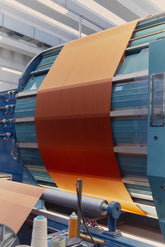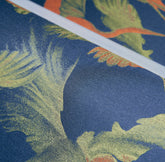
Mantero's textile tradition began in the 1940s when it acquired the Menaggio weaving company. This was an extremely important industrial asset, meeting the wartime demand for military silk supplies to make parachutes.
Mantero’s weaving department is a modern, spacious factory with more than 50 employees. It has 32 jacquard looms, two heddle looms, two warpers and a winder for fine silk yarns. The wide loom-worked fabric range is differentiated by technique, type of yarn, processing, composition, different weights, structures, aspects and uses – ranging from the lightweight silk chiffon to jacket fabric, from clothing to accessories.

Once the yarns have been chosen, the threads must be "put together" on a single support called a warp beam, to create a chain. This process can be carried out traditionally on a production warper or a special warper for smaller lengths and samples.
Once the yarns have been chosen, the threads must be "put together" on a single support called a warp beam, to create a chain. This process can be carried out traditionally on a production warper or a special warper for smaller lengths and samples.
Read More
Read Less

The warps, also known as chains, differ in the number of threads and piece height. Tie warp beams are made up of a total of 16.800 threads - 117 per cm - allowing the production of extremely compact fabrics. Clothing warp beams can have between 40 and 117 threads per cm, while those for accessories and scarves range from 15 to 94 threads per cm. Fewer threads per cm enables the production of looser and softer fabrics.
The warps, also known as chains, differ in the number of threads and piece height. Tie warp beams are made up of a total of 16.800 threads - 117 per cm - allowing the production of extremely compact fabrics. Clothing warp beams can have between 40 and 117 threads per cm, while those for accessories and scarves range from 15 to 94 threads per cm. Fewer threads per cm enables the production of looser and softer fabrics.
Read More
Read Less

The warp beams - a large spool where the warp threads are wound - are placed on the back of the looms where the chain knotting process takes place. Weft preparators are placed on a rack to improve the unwinding of the yarn from the spool. A comb is mounted and through this the evenly spaced chain strands pass, pushing each weft against the previous one to create the fabric.
The warp beams - a large spool where the warp threads are wound - are placed on the back of the looms where the chain knotting process takes place. Weft preparators are placed on a rack to improve the unwinding of the yarn from the spool. A comb is mounted and through this the evenly spaced chain strands pass, pushing each weft against the previous one to create the fabric.
Read More
Read Less

Our weaving department uses a wide range of textile fibres, natural and valuable like silk, cashmere, Resilk®, and patterned artificial and synthetic fabrics, offering special innovative and customised solutions.
Our weaving department uses a wide range of textile fibres, natural and valuable like silk, cashmere, Resilk®, and patterned artificial and synthetic fabrics, offering special innovative and customised solutions.
Read More
Read Less

Our creatives and technicians’ skill combinations lead to the fabric creation and construction in several steps. After the initial research and sketches, the next step is the fabric weave selection and definition. The weave graphic representation is called "messincarta". The most suitable yarns for the design must be selected by thickness and suitability for the fabric’s characteristics. A first feasibility test is carried out on the loom and then we dedicate to the various versions, making the different colour proposals of the same design to select the most appropriate combinations.
Our creatives and technicians’ skill combinations lead to the fabric creation and construction in several steps. After the initial research and sketches, the next step is the fabric weave selection and definition. The weave graphic representation is called "messincarta". The most suitable yarns for the design must be selected by thickness and suitability for the fabric’s characteristics. A first feasibility test is carried out on the loom and then we dedicate to the various versions, making the different colour proposals of the same design to select the most appropriate combinations.
Read More
Read Less

With its in-house design studio, creative talents and state-of-the-art looms, Mantero creates extraordinary full-field designs up to two metres tall with a theoretically unlimited length. Precise and rich interpretation of creative ideas to be made with the latest weaving technologies is a daily challenge for our team.
With its in-house design studio, creative talents and state-of-the-art looms, Mantero creates extraordinary full-field designs up to two metres tall with a theoretically unlimited length. Precise and rich interpretation of creative ideas to be made with the latest weaving technologies is a daily challenge for our team.
Read More
Read Less





